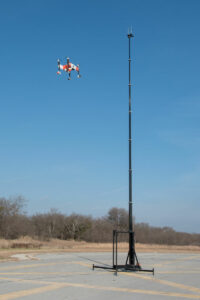February 10, 2022
Bell performs detect and avoid test with APT drone, 429 helicopter
Jon Robinson
Bell Textron Inc.’s Autonomous Pod Transport drone successfully completed a demonstration of a ground-based Detect and Avoid flight, fulfilling an extension for its NASA Systems Integration and Operationalization program. Bell was selected for NASA’s Systems Integration and Operationalization (SIO) program back in 2018, aiming to help develop future airspace requirements for future Advanced Air Mobility vehicles, such as commercial drones and potentially autonomous eVTOL aircraft like so-called air taxis.
Bell in Sept. 2020 completed its first SIO demonstration flight with the Autonomous Pod Transport (70) aircraft, running a Beyond Visual Line-of-Sight (BVLOS) mission with NASA in an urban environment, transitioning into and out of Class B airspace representing future commercial flights.
 This newest 2022 Detect and Avoid (DAA) demonstration, explains Bell, showcased the APT’s ground radar system integration and its capabilities when navigating airspace traffic and requirements. Again, the SIO objective was to execute a BVLOS mission in complex airspace, but in the instance while utilizing DAA technology to monitor the airspace for ‘natural intruders’ using Bell’s 429 commercial helicopter and APT drone.
This newest 2022 Detect and Avoid (DAA) demonstration, explains Bell, showcased the APT’s ground radar system integration and its capabilities when navigating airspace traffic and requirements. Again, the SIO objective was to execute a BVLOS mission in complex airspace, but in the instance while utilizing DAA technology to monitor the airspace for ‘natural intruders’ using Bell’s 429 commercial helicopter and APT drone.
Bell’s QuantiFLYTM system, a new aircraft communication unit (ACU) powered by Truth Data, offering a true low-cost, lightweight, and fully automatic flight data monitoring (FDM) solution, was used on the Bell 429 to record aircraft telemetry data.
Bell utilized radar systems to monitor the complex airspace within the AllianceTexas Mobility Innovation Zone (MIZ) and to track manned and unmanned aircraft systems. (Photo: Bell Textron)
“We are excited to demonstrate the effectiveness of ground-based monitoring solutions as part of UAS infrastructure,” said Matt Holvey, director, Intelligent Systems, Bell. “Radar monitoring, whether airborne or ground-based, may become an important part of drone delivery, air taxi services and other aspects of the ever-expanding AAM ecosystem.”
In addition, Microsoft provided AirSim, a simulation tool for training Autonomous systems, which gave Bell a Digital Twin environment to model the NASA SIO Extension flight in the virtual world before flying through the corridor. This allowed the team to conduct simulated real-world tests of the APT aircraft across a broad range of scenarios without any safety risks and at a fraction of the cost and time needed.
(Photo: Bell Textron)
